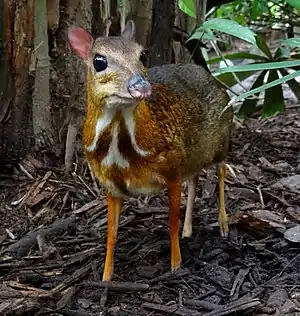chevrotain
English
WOTD – 22 May 2022
Etymology

The kanchil, lesser Malay chevrotain, or lesser mouse-deer (Tragulus kanchil), a species of chevrotain.
Borrowed from French chevrotain, chevrotin (“ruminant of the family Tragulidae”), the diminutive of Old French chevrot (“young goat, kid”), itself a diminutive of chievre (“goat”) (modern French chèvre (“she-goat”)) + -ot (diminutive suffix).[1] Chievre is derived from Latin capra (“she-goat”), from caper (“billy goat, he-goat”) (ultimately from Proto-Indo-European *kápros (“billy goat, he-goat”)) + -a (suffix forming feminine counterparts of masculine nouns).
Pronunciation
- (Received Pronunciation) IPA(key): /ˈʃɛvɹə(ʊ)teɪn/
Audio (Southern England) (file) - (General American) IPA(key): /ˈʃɛvɹəˌteɪn/
- Hyphenation: che‧vrot‧ain
Noun
chevrotain (plural chevrotains)
- Any of several small hornless ruminants of the family Tragulidae (genera Hyemoschus, Moschiola, and Tragulus), native to tropical rainforests of South and Southeast Asia, and Central and West Africa; a mouse deer.
- 1791, Oliver Goldsmith, “Of Animals of the Sheep and Goat Kind”, in An History of the Earth, and Animated Nature. […], new edition, volume III, London: […] F[rancis] Wingrave, successor to Mr. [John] Nourse, […], →OCLC, page 76:
- To this vve may add the Chevrotin, or little Guinea Deer, vvhich is the leaſt of all cloven-footed quadrupeds, and perhaps the moſt beautiful; its legs, at the ſmalleſt part, are not much thicker than the ſhank of a tobacco-pipe; it is about ſeven inches high, and about tvvelve from the point of the noſe to the inſertion of the tail.
Hyponyms
- Balabac chevrotain (Tragulus nigricans)
- Indian spotted chevrotain (Moschiola indica)
- larger Malayan chevrotain
- larger Malay chevrotain
- lesser Malayan chevrotain
- lesser Malay chevrotain
- silver-backed chevrotain (Tragulus versicolor)
- Sri Lankan spotted chevrotain (Moschiola meminna)
- water chevrotain (Hyemoschus aquaticus)
- yellow-striped chevrotain (Moschiola kathygre)
Translations
any of several small hornless ruminants of the family Tragulidae
|
References
- “chevrotain | chevrotin, n.”, in OED Online
 , Oxford, Oxfordshire: Oxford University Press, December 2019; “chevrotain, n.”, in Lexico, Dictionary.com; Oxford University Press, 2019–2022.
, Oxford, Oxfordshire: Oxford University Press, December 2019; “chevrotain, n.”, in Lexico, Dictionary.com; Oxford University Press, 2019–2022.
Further reading
 chevrotain on Wikipedia.Wikipedia
chevrotain on Wikipedia.Wikipedia  Category:Tragulidae on Wikimedia Commons.Wikimedia Commons
Category:Tragulidae on Wikimedia Commons.Wikimedia Commons  Tragulidae on Wikispecies.Wikispecies
Tragulidae on Wikispecies.Wikispecies - “chevrotain”, in OneLook Dictionary Search.
This article is issued from Wiktionary. The text is licensed under Creative Commons - Attribution - Sharealike. Additional terms may apply for the media files.